
Protaspididae is an extinct family of pteraspidid heterostracan agnathans. Fossils of the various genera are found in early Devonian-aged marine strata. Protaspidids were once thought to represent a transitional form between the Pteraspididae and the Psammosteida, bearing the broad head shield shape of the latter, due to a more benthic (bottom-dwelling) existence, but recent phylogenical comparisons demonstrate that the protaspidids are actually highly derived pteraspidids, and that the anchipteraspidids, the most primitive of pteraspidids, are the sister-group of the Psammosteids.
The Black Peaks Formation is a geological formation in Texas whose strata date back to the Late Cretaceous. Dinosaur remains and the pterosaur Quetzalcoatlus northropi have been among the fossils reported from the formation. The boundary with the underlying Javelina Formation has been estimated at about 66.5 million years old. The formation preserves the rays Rhombodus and Dasyatis, as well as many gar scales.

Paleontology in Pennsylvania refers to paleontological research occurring within or conducted by people from the U.S. state of Pennsylvania. The geologic column of Pennsylvania spans from the Precambrian to Quaternary. During the early part of the Paleozoic, Pennsylvania was submerged by a warm, shallow sea. This sea would come to be inhabited by creatures like brachiopods, bryozoans, crinoids, graptolites, and trilobites. The armored fish Palaeaspis appeared during the Silurian. By the Devonian the state was home to other kinds of fishes. On land, some of the world's oldest tetrapods left behind footprints that would later fossilize. Some of Pennsylvania's most important fossil finds were made in the state's Devonian rocks. Carboniferous Pennsylvania was a swampy environment covered by a wide variety of plants. The latter half of the period was called the Pennsylvanian in honor of the state's rich contemporary rock record. By the end of the Paleozoic the state was no longer so swampy. During the Mesozoic the state was home to dinosaurs and other kinds of reptiles, who left behind fossil footprints. Little is known about the early to mid Cenozoic of Pennsylvania, but during the Ice Age it seemed to have a tundra-like environment. Local Delaware people used to smoke mixtures of fossil bones and tobacco for good luck and to have wishes granted. By the late 1800s Pennsylvania was the site of formal scientific investigation of fossils. Around this time Hadrosaurus foulkii of neighboring New Jersey became the first mounted dinosaur skeleton exhibit at the Academy of Natural Sciences in Philadelphia. The Devonian trilobite Phacops rana is the Pennsylvania state fossil.
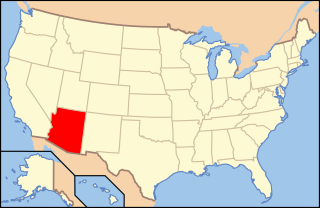
Paleontology in Arizona refers to paleontological research occurring within or conducted by people from the U.S. state of Arizona. The fossil record of Arizona dates to the Precambrian. During the Precambrian, Arizona was home to a shallow sea which was home to jellyfish and stromatolite-forming bacteria. This sea was still in place during the Cambrian period of the Paleozoic era and was home to brachiopods and trilobites, but it withdrew during the Ordovician and Silurian. The sea returned during the Devonian and was home to brachiopods, corals, and fishes. Sea levels began to rise and fall during the Carboniferous, leaving most of the state a richly vegetated coastal plain during the low spells. During the Permian, Arizona was richly vegetated but was submerged by seawater late in the period.
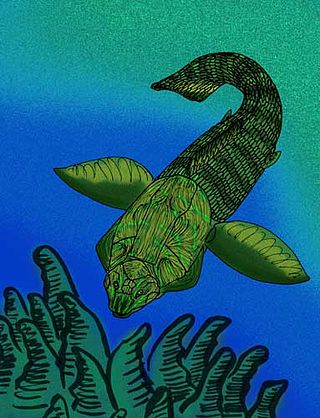
Holonematidae is an extinct family of relatively large arthrodire placoderms from the Early to Late Devonian. Almost all fossil specimens are of armor fragments, though, all have distinctive ornamentation, often of unique arrangements and patterns of tubercles, that are diagnostic of the family. The trunkshield is very elongated, giving the armor an overall "barrel" like appearance.
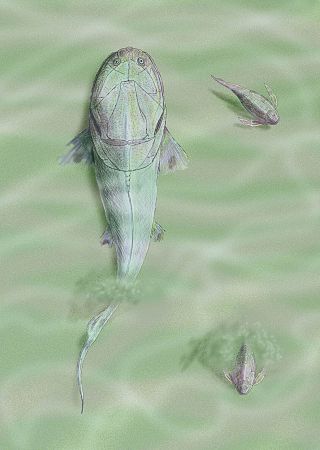
Homostiidae is a family of flattened arthrodire placoderms from the Early to Middle Devonian. Fossils appear in various strata in Europe, Russia, Morocco, Australia, Canada and Greenland.
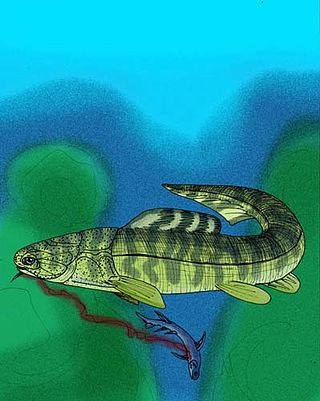
Buchanosteidae is a family of arthrodire placoderms that lived from the Early to Middle Devonian. Fossils appear in various strata in Russia, Central Asia, Australia, and China.
Microbrachiidae is an extinct family of tiny, advanced antiarch placoderms closely related to the bothriolepidids.
The Cabrillo Formation is a Maastrichtian stage geologic formation in coastal San Diego County, southern California. It is part of the Rosario Group. The Maastrichtian stage is of the Late Cretaceous Epoch, during the Mesozoic Era.
The Lost Burro Formation is a Middle to Upper/Late Devonian geologic formation in the Mojave Desert of California in the Western United States.
The Hidden Valley Dolomite is a Silurian−Devonian geologic formation in the northern Mojave Desert of California, in the western United States.
The Mountain Springs Formation is Devonian stratigraphic unit in Arizona. The remains of both antiarch and arthrodire placoderms are known from the formation.
The Wood Bay Series is a geologic formation found on the island of Spitsbergen, Svalbard in Norway. It preserves fossils dating back to the Pragian–Emsian stages of the Devonian period.

Panamintaspis snowi is an extinct species of pteraspidid heterostracan agnathan which existed during the early Middle Devonian period of Death Valley, California. Fossils are found in Late Emsian-aged marine strata of the Lost Burro Formation. P. snowi strongly resembles Pteraspis, though while it was originally described as a member of the same family, Pteraspididae, a recent phylogenetic reassessment of the order Pteraspidiformes places P. snowi within the paraphyletic family "Protopeteraspidae," as the sister taxon of the suborder Pteraspidoidei.

Pteraspidiformes is an extinct order of heterostracan agnathan vertebrates known from extensive fossil remains primarily from Early Devonian strata of Europe and North America, and from Upper Silurian Canada.
Squatirhina is a genus of Late Cretaceous cartilaginous fish whose fossils have been found in the Aguja and Pen Formations of Big Bend National Park, Texas, USA.

Burrow fossils are the remains of burrows - holes or tunnels excavated into the ground or seafloor - by animals to create a space suitable for habitation, temporary refuge, or as a byproduct of locomotion preserved in the rock record. Because burrow fossils represent the preserved byproducts of behavior rather than physical remains, they are considered a kind of trace fossil. One common kind of burrow fossil is known as Skolithos, and the similar Trypanites, Ophiomorpha and Diplocraterion.

Anglaspis is an extinct genus of cyathaspidiform heterostracan agnathan. Fossils are found in marine strata of Europe, from the late Silurian period until the genus' extinction during the Early Devonian. As with other cyathaspidiforms, individuals of Anglaspis had dorsal and ventral plates covering the forebody, gill pouches, and nasal openings that lay on the roof of the oral cavity.

Protopteraspididae is an extinct family of pteraspidid heterostracan agnathans. Fossils of the various genera are found in early Devonian-aged marine strata. Protopteraspidids were once thought to represent a taxon of basal pteraspidids but recent evaluations demonstrate that Protopteraspididae is a paraphyletic group of various transitional forms representing a gradual transition between the more advanced Pteraspoidei, and the anchipteraspidids and the Psammosteids.
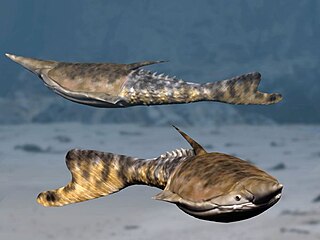
Pteraspididae is an extinct family of heterostracan vertebrates. It is an Early Devonian-aged family that contains the stereotypical, torpedo-shaped pteraspidids, such as the type genus, Pteraspis, and its close relatives Errivaspis and Rhinopteraspis, that are popularly thought to have actively swam about in the water column. The elongated rostral plate is thought to help with their hydrodynamic ability. Various genera are found in various marine and estuarine strata of Early Devonian Europe and North America.












